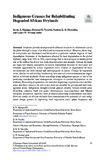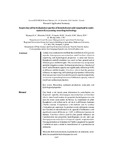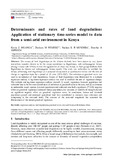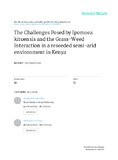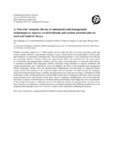Search
Now showing items 1-10 of 11
Indigenous Grasses for Rehabilitating Degraded African Drylands
(2019)
Drylands provide an important livelihood stream to its inhabitants across the globe through a range of products and ecosystem services. However, these fragile ecosystems are threatened and believed to experience various ...
Dry matter yields and hydrological properties of three perennial grasses of a semi-arid environment in east Africa
(2010)
Enteropogon macrostachyus (Bush rye), Cenchrus ciliaris L. (African foxtail grass) and Eragrostis superba Peyr (Maasai love grass) are important perennial rangeland grasses in Kenya. They provide an important source of ...
Improving soil hydrological properties of denuded semi-arid rangeland in southeastern Kenya using reseeding technology
(2010)
A study was conducted to establish the contribution of Eragrostis superba, Enteropogon macrostachyus and Cenchrus ciliaris in improving soil hydrological properties in semi-arid Kenya. Kamphorst rainfall simulator was used ...
Different land use types in the semi-arid rangelands of Kenya influence soil properties
(2011)
Rangelands in semi-arid Kenya have recently witnessed extensive land use changes. These changes can mainly be attributed to increased livestock populations and the response of the increased human population to both local ...
Competition indices of three perennial grasses used to rehabilitate degraded semi-arid rangelands in Kenya
(2015)
Rangeland degradation is one of the most serious environmental challenges in arid and semiarid environments in Africa. Grass reseeding technology, using indigenous perennial grass species has a great potential for restoring ...
The choice of grass species to combat desertification in semi-arid Kenyan rangelands is greatly influenced by their forage value for livestock
(2013)
Livestock production is the main source of livelihood in the arid and semi-arid lands in Africa. However, desertification characterized by vegetation degradation and soil erosion is a major threat to the sustainability of ...
Determinants and rates of land degradation: Application of stationary time-series model to data from a semi-arid environment in Kenya
(Springer, 2018-02)
The causes of land degradation in the African drylands have been shown to vary. Some researchers consider climate to be the major contributor to degradation, with anthropogenic factors playing a minor role. Others reverse ...
The Challenges Posed by Ipomoea kituensis and the Grass-Weed Interaction in a reseeded semi-arid environment in Kenya
(2016)
Rehabilitation of denuded patches using perennial grasses has been used
extensively in semi-arid environments of Kenya. However, weeds
continue to pose an enormous challenge to the success of many
rehabilitation programmes. ...
The Role of Moisture in the Successful Rehabilitation of Denuded Patches of a Semi-Arid Environment in Kenya
(2005)
This study investigated the role of moisture in the successful rehabilitation of denuded patches in semi-arid lands of Kenya and the primary productivity of three perennial rangelands grasses namely Cenchrus ciliaris ...
A “win-win” scenario: the use of sustainable land management technologies to improve rural livelihoods and combat desertification in semi-arid lands in Kenya
(2014)
Dryland ecosystems support over 2 billion people and are major providers of critical ecosystems goods and services globally. However, desertification continues to pose a serious threat to the sustainability of the drylands ...

